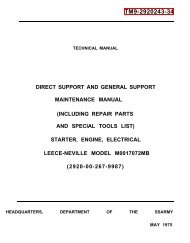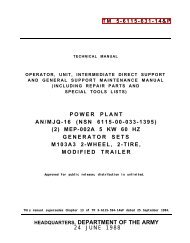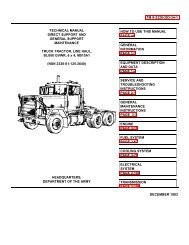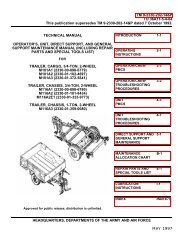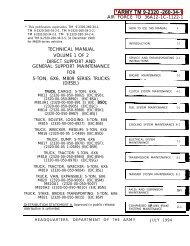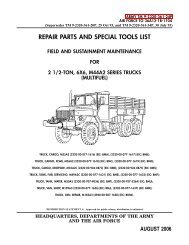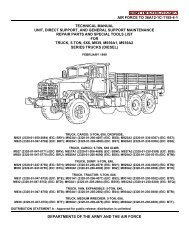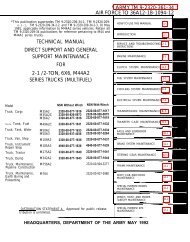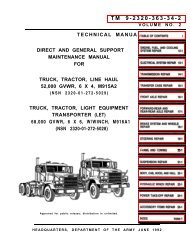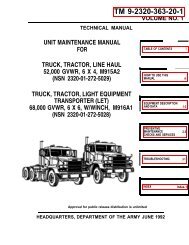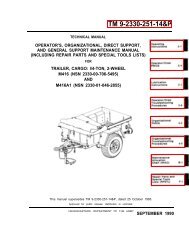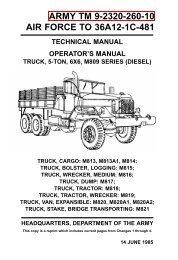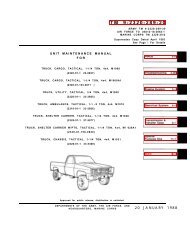VEHICLE RECOVERY - Pirate4x4.Com
VEHICLE RECOVERY - Pirate4x4.Com
VEHICLE RECOVERY - Pirate4x4.Com
You also want an ePaper? Increase the reach of your titles
YUMPU automatically turns print PDFs into web optimized ePapers that Google loves.
FM 21-305/AFMAN 24-306Construct anchors when natural ones are not available.The deadman is one of the best types of constructedanchors and can be used for heavy loads(Figure 22-2). It consists of a log timber, steelbeam, or other similar object buried in the groundwith a deadline connected to it at the center. Toconstruct a deadman, follow these steps:Select a place where the direction of pull is asnearly horizontal as possible, such as a sharpbank or crest. Thus, you obtain moreholding power with less digging.When digging slant the bank at least 15degrees from the vertical and undercut towardthe disabled vehicle.Drive stakes in front of the deadman at eachend to hold it in place.Tie the deadline to the center of the deadmanso the main or standing part of the line leadsfrom the bottom of the deadman. Dig anarrow trench for the deadline; bear to thecenter of the deadman. If the deadline has atendency to cut into the ground, place a log orplank under the line at the outlet from theinclined trench.Tie the deadline to the center of the deadmanso the main part of the line leads to thebottom. This will keep the deadman fromrotating out of the hold. -WINCH <strong>RECOVERY</strong>Many military trucks are equipped with winches.how how to get the most from a winch withoutdanger to personnel or abuse to the equipment.For Army Only: Your vehicle technical manualcompletely describes the winch on your vehicleand details of its operation, care, and maintenance.FM 20-22 explains general characteristics, effectivecapacities, and details for use.To ensure your safety, the protection of your equipment,and the success of your recovery operation,use the following as a guide:Check the capacity of your winch. Thecapacity shown on the manufacturer’s plate isthe maximum with one layer of cable on thedrum. Each successive layer increases thediameter of the drum and reduces the winchcapacity to as little as 50 percent of the ratedcapacity when the last layer is being wound onthe drum.Check the cable for rust, kirks, or frays.Estimate the total resistance. Consider grade orslope, weight of the vehicle, and type of terrain.Then add a reasonable factor for safety.Check your equipment. Be sure you rig safelyto overcome the resistance with the equipmentavailable.Select or provide a suitable anchor.Remember, the purpose of this operation isto recover a vehicle, not to pull stumps.Rig and check rigging. Do not put power onyour winch until you check every element inyour rigging and are satisfied that you madeno mistakes.Clear personnel from the danger area. Allpersons observing the operation should standoutside the angle formed by the cable understress at a distance at least equal to thedistance between the two most distant pointsin the rigging. Clear personnel away beforetightening the cable.22-2



